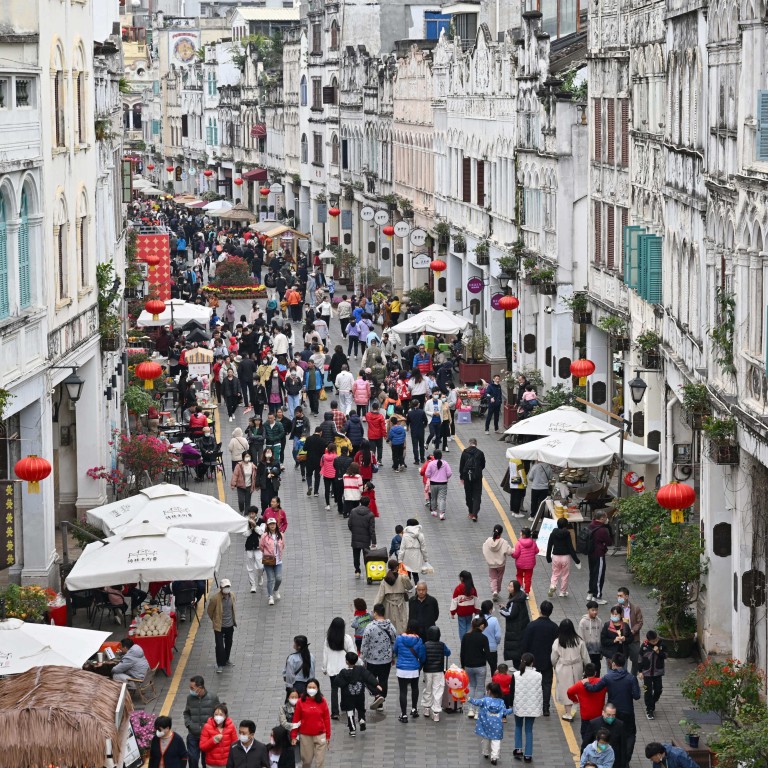
China’s factory, services activity enjoys ‘rapid’ economic rebound in February after reopening
- China’s official manufacturing purchasing managers’ index (PMI) rose to 52.6 in February, while the non-manufacturing gauge rose to 56.3 last month
- Caixin/S&P Global manufacturing PMI also rose to 51.6 last month, up from 49.2 in January.
China enjoyed a “rapid near-term rebound” in February as factory and services activity continued their rally last month, data released on Wednesday showed, but the foundations of an overall economic recovery are “not yet solid” due to lingering coronavirus factors, according to analysts.
The official non-manufacturing PMI, which measures business sentiment in the services and construction sectors, rose to 56.3 in February from 54.4 in January.
The latest survey data is exceptionally strong, consistent with our expectation for a rapid near-term rebound in economic activity
“The latest survey data is exceptionally strong, consistent with our expectation for a rapid near-term rebound in economic activity,” Julian Evans-Pritchard, head of China economics at Capital Economics.
“The high PMI readings partly reflect the economy’s weak starting point coming into this year and are likely to drop back before long as the pace of the recovery slows.
Within the official manufacturing PMI, the new orders subindex rose to 54.1 in February from 50.9 in January, while the new export orders subindex increased to 52.4 from 46.1, representing the first expansionary reading in 23 months.
“February’s PMIs all came in well above market expectations,” said analysts at Nomura, who pointed to the low base of the official manufacturing gauge in January following three consecutive months of contraction at the end of 2022 as having also contributed to February’s increase.
“The official manufacturing PMI jumped to 52.6 in February from 50.1 in January, the highest reading since April 2012, thanks to the fast resumption of manufacturing activity following the Lunar New Year holiday, with the pandemic finally behind us.”
The official composite PMI, which includes both manufacturing and services activity, rose to 56.4 in February, up from 52.9 in January.
“In February, the economic-stabilisation policy measures further took effect, coupled with the epidemic’s impact receding and other favourable factors, the speed of enterprises to resume production accelerated, meaning China’s economic prosperity level continued to rebound,” said senior NBS statistician Zhao Qinghe.
“We also see that the percentage of manufacturing and service sector companies that reflected a lack of orders in the survey has decreased compared with last month, but still exceeds 50 per cent, indicating that the problem of insufficient market demand is still prominent, and the foundation of China’s economic recovery still needs to be strengthened, and the subsequent trend of the purchasing managers’ index needs to be further observed.”
The strength in the Caixin PMI aligned with the official survey, that showed China’s factory activity gained steam. The Caixin PMI reading marked the first monthly expansion since July and the highest reading since June.
The removal of stringent coronavirus-containment measures has helped restore business operations and client demand, sending factory-output growth to the highest level since June as workers recovered from infections.
New orders expanded for the first time since July and grew at the quickest pace since May 2021.
Surveyed firms also noted an improvement in foreign demand for Chinese manufactured goods, with new export orders expanding for the first time since July, providing some comfort for exporters amid slowing global economic growth.
Manufacturers pushed up charges for exported items due to higher input costs and improved demand.
The impact of the pandemic remains far-reaching. Currently, the foundation for economic recovery is not yet solid, and it will take time to fully restore production and social order to normal
Although staffing levels in the sector rose for the first time in nearly a year, there were signs of increased pressure on operating capacity with the backlog of work up for the second straight month.
Business confidence, however, continued to strengthen with overall optimism at the highest point since March 2021.
“In a nutshell for February, the economy saw a faster pace of recovery following a peak in the recent wave of Covid infections as supply and demand expanded, overseas demand surged, employment started to rebound, and logistics recovered at a faster pace,” said Wang Zhe, senior economist at Caixin Insight Group.
“But the impact of the pandemic remains far-reaching. Currently, the foundation for economic recovery is not yet solid, and it will take time to fully restore production and social order to normal.”
Additional reporting by Mia Nulimaimaiti, Reuters

.JPG?itok=J8tgfPmW&v=1659948715)